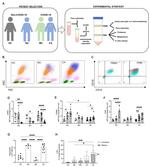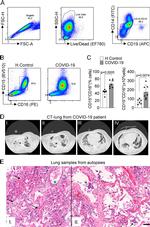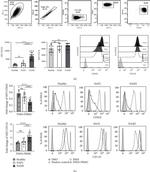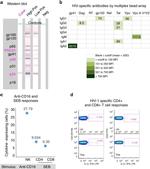Search Thermo Fisher Scientific
Invitrogen
CD16 Monoclonal Antibody (eBioCB16 (CB16)), Biotin, eBioscience™
This Antibody was verified by Relative expression to ensure that the antibody binds to the antigen stated.
FIGURE: 1 / 28
CD16 Antibody (13-0168-82) in Flow




























Product Details
13-0168-82
Species Reactivity
Published species
Host/Isotype
Recommended Isotype Control
Class
Type
Clone
Conjugate
Form
Concentration
Purification
Storage buffer
Contains
Storage conditions
Shipping conditions
RRID
Product Specific Information
Description: The eBioCB16 monoclonal antibody recognizes CD16 (Fc gammaRIII), the low-affinity receptor for IgG with an apparent molecular weight of 50-80 kDa. CD16 is represented by two similar genes, CD16A (Fc gammaRIIIA), which exists as a hetero-oligomeric polypeptide-anchored form in macrophages and NK cells and CD16B (Fc gammaRIIIB), which exist as a monomeric GPI-anchored form in neutrophils. Furthermore, there are two known polymorphisms of CD16B, NA-1 and NA-2. Individuals homozygous for NA-2 show a lower phagocytic capacity compared with NA-1. CD16 binds IgG in the form of immune complexes and shows preferential binding of IgG1 and IgG3 isotypes and minimal binding of IgG2 and IgG4. Upon IgG binding, both CD16 isoforms initiate signal transduction cascades that lead to a variety of responses including antibody-dependent cell-mediated cytotoxicity (ADCC), phagocytosis, degranulation and proliferation.
Applications Reported: This eBioCB16 (CB16) antibody has been reported for use in flow cytometric analysis.
Applications Tested: This eBioCB16 (CB16) antibody has been tested by flow cytometric analysis of normal normal human peripheral blood cells. This can be used at less than or equal to 0.125 µg per test. A test is defined as the amount (µg) of antibody that will stain a cell sample in a final volume of 100 µL. Cell number should be determined empirically but can range from 10^5 to 10^8 cells/test. It is recommended that the antibody be carefully titrated for optimal performance in the assay of interest.
Filtration: 0.2 µm post-manufacturing filtered.
Target Information
CD16 encodes a receptor that recognizes the Fc portion of immunoglobulin G and is involved in the clearance of immune complexes from the circulation, as well as other functions such as cellular mediated cytotoxicity and enhancement of virus infections. This gene, FCGR3A, shares a high degree of similarity with another nearby gene, FCGR3B, located on chromosome 1. The receptor encoded by this gene is expressed on natural killer (NK) cells as an integral membrane glycoprotein anchored through a transmembrane peptide, while FCGR3B is expressed on polymorphonuclear neutrophils (PMN) where the receptor is anchored through a phosphatidylinositol (PI) linkage. Mutations in this gene have been associated with immunodeficiency 20 and have been linked to susceptibility to recurrent viral infections, susceptibility to systemic lupus erythematosus, and alloimmune neonatal neutropenia. Alternatively spliced transcript variants encoding different isoforms have been found for this gene. Diseases associated with FCGR3A include Immunodeficiency 20 and Herpes Zoster.
For Research Use Only. Not for use in diagnostic procedures. Not for resale without express authorization.
Bioinformatics
Protein Aliases: CD16-I; CD16-II; CD16a; CD16a antigen; CD16b; CD32 receptor 2; Fc fragment of IgG low affinity IIIa receptor; Fc fragment of IgG, low affinity III, receptor for (CD16); Fc fragment of IgG, low affinity IIIa, receptor (CD16a); Fc fragment of IgG, low affinity IIIb, receptor (CD16b); Fc gamma receptor III-A; Fc gamma receptor IIIa; Fc gamma receptor IIIb; Fc-gamma receptor III-2 (CD 16); Fc-gamma receptor IIIb (CD 16); Fc-gamma receptor IIIb (CD16); Fc-gamma RIII; Fc-gamma RIII-alpha; Fc-gamma RIII-beta; Fc-gamma RIIIa; fc-gamma RIIIb; FCG2; FcgammaRIIIA; FCGR2; FCGR2A; FCGR2B; FCGR2C; FcR-10; FcRII-b; FcRII-c; IgG Fc receptor III-1; IgG Fc receptor III-2; IgG Fc receptor III-A; immunoglobulin G Fc receptor III; Low affinity immunoglobulin gamma Fc region receptor III-A; Low affinity immunoglobulin gamma Fc region receptor III-B; neutrophil-specific antigen NA; RP11-5K23.1
Gene Aliases: CD16; CD16A; CD16B; FCG3; FCGR3; FCGR3A; FCGR3B; FCGRIII; FCR-10; FCRIII; FCRIIIA; FCRIIIb; IGFR3; IMD20
UniProt ID: (Human) P08637, (Human) O75015
Entrez Gene ID: (Human) 2214, (Human) 2215

Performance Guarantee
If an Invitrogen™ antibody doesn't perform as described on our website or datasheet,we'll replace the product at no cost to you, or provide you with a credit for a future purchase.*
Learn more
We're here to help
Get expert recommendations for common problems or connect directly with an on staff expert for technical assistance related to applications, equipment and general product use.
Contact tech support
